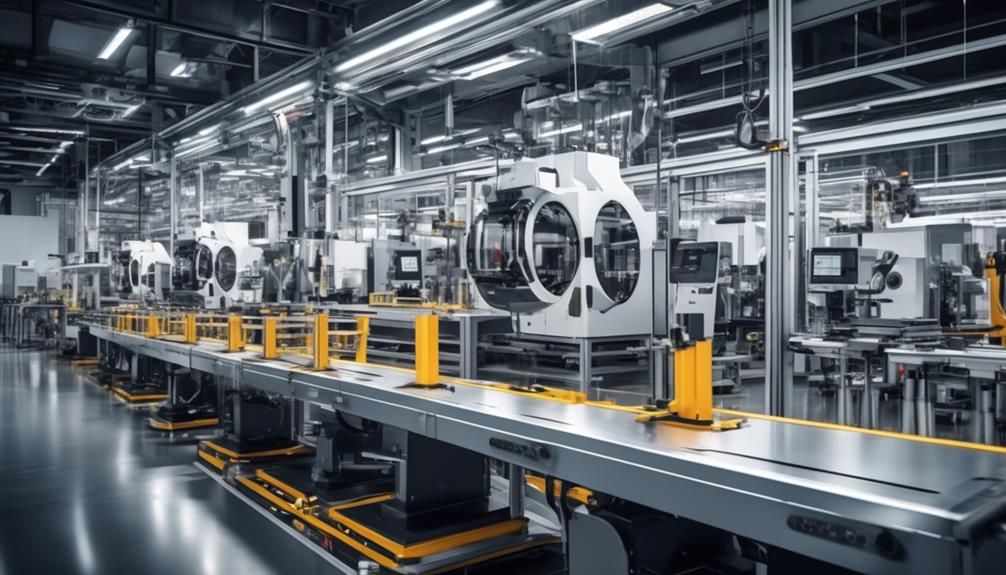Quality Control Solutions
8 Best Practices for ISO Quality Certification Steps
Achieve ISO quality certification with confidence and efficiency by following these 8 best practices for a seamless certification process.

As a business, we have collectively encountered challenges in ensuring our services and products meet the highest standards of quality. To achieve ISO quality certification, there are eight fundamental strategies that can simplify and improve the process of obtaining the certification.
From planning and preparation to maintaining certification, each step plays a crucial role in the successful implementation of ISO standards within an organization.
But what are these best practices, and how can they be applied to ensure a seamless certification process?
Let's explore each step and uncover the strategies for achieving ISO quality certification with confidence and efficiency.
Key Takeaways
- Appoint a dedicated ISO 9001 point person to oversee the certification process.
- Tailor the ISO 9001 system to fit the unique needs of the company.
- Implement corrective or preventive actions to drive continual improvement.
- Conduct a thorough internal audit to identify gaps in compliance with ISO 9001 and enhance processes and procedures.
Planning and Preparation
In preparing for ISO quality certification, it's essential to appoint a dedicated ISO 9001 point person and secure executive support to define the scope and establish goals for the implementation process. This requires a deep understanding of the ISO 9001:2015 standard and its requirements.
Our organization must ensure that management is well-versed in the standard through comprehensive training. It's crucial to lay a solid foundation for certification success by meticulously planning and setting achievable goals. The ISO 9001 system should be tailored to fit our company's unique needs, ensuring that it aligns with our existing processes rather than forcing us to adapt to it.
We must understand that the immediate success and long-term sustainability of ISO 9001 certification depend on our thorough preparation. Compliance with the ISO standards necessitates meticulous planning, attention to detail, and a proactive approach to aligning our organization's processes with the requirements.
It's imperative that our management takes an active role in driving the planning process to ensure that the ISO 9001 certification journey is seamlessly integrated into our organizational structure and operations.
Documentation Requirements

Our organization is currently in the process of interpreting and developing documentation requirements tailored to our specific needs and processes for ISO certification. It is crucial to align our documentation with the ISO 9001 requirements and our operational procedures. Introducing these documents to our employees will aid in their understanding and adaptation to the new procedures, ensuring a smooth transition to the ISO standard. Internal audits are imperative to verify the effective implementation of the documentation requirements before seeking certification. The certification audit, conducted by an independent registrar, marks the achievement of ISO 9001 certification.
| Documentation Requirements | ISO 9001 Certification | Compliance and Certification |
|---|---|---|
| Interpret and develop tailored documentation | Ensure alignment with ISO 9001 requirements | Verify compliance through internal audits |
| Introduce documents to employees | Aid in understanding and adaptation | Ensure effective implementation before certification |
| Certification audit by independent registrar | Marks achievement of ISO 9001 certification | Validates compliance and certification |
In developing our documentation requirements, we must adhere to best practices and create a systematic approach to ensure compliance and certification.
Implementation Strategies
We will strategize the implementation of ISO quality certification by meticulously outlining specific action steps and assigning responsible parties.
- Establish a Quality Management System (QMS):
- Align our organization with ISO 9001 requirements
- Identify processes and define responsibilities
- Ensure effective planning, operation, and control of processes
- Conduct management review meetings to evaluate the suitability, adequacy, and effectiveness of the QMS.
- Implement Corrective or Preventive Actions:
- Develop a systematic approach to managing nonconformities
- Implement corrective or preventive action as a crucial part of our ISO system
- Identify root causes and evaluate risks
- Take proactive measures to prevent recurrence.
- Drive Continual Improvement:
- Integrate management principles into our organization for ISO
- Foster a culture of continual improvement
- Set objectives, measure performance, and implement actions to enhance our QMS
- Ensure consistent delivery of value to customers and meeting regulatory requirements.
Internal Audit Preparation

Preparation for the internal audit involves meticulously reviewing our quality management processes and documentation to ensure compliance with ISO standards and identifying areas for improvement. As part of this process, conducting thorough gap analyses is crucial to pinpoint any deviations from the ISO 9001 standard. By assessing our quality management systems (QMS) against the requirements of the standard, we can identify areas needing corrective actions and enhance our processes and procedures.
Here's a table to illustrate the key steps in internal audit preparation:
| Key Steps | Description |
|---|---|
| Gap Analysis | Assess QMS against ISO 9001 standard to identify non-conformities and areas for improvement. |
| Review of QMS | Evaluate documentation, processes, and procedures to ensure alignment with ISO requirements. |
| Identification of Gaps | Identify specific areas where our QMS may not meet the criteria of the ISO 9001 standard. |
This meticulous preparation sets the stage for a successful internal audit, ensuring our organization's compliance with ISO standards and facilitating continuous improvement in our quality objectives.
Selecting a Registrar
Selecting a registrar for ISO certification involves assessing their accreditation, industry experience, auditing approach, and post-certification support to ensure alignment with our organization's needs and objectives.
1) Accreditation and Reputation: We must verify the registrar's accreditation and reputation to ensure their credibility and recognition within the industry. This step is crucial to guarantee that the certification audit holds value and is widely accepted.
2) Industry Experience: It's vital to evaluate the registrar's experience within our specific industry. This ensures that the registrar comprehends our unique organizational needs, processes, and challenges, leading to a more effective and insightful certification audit.
3) Auditing Approach and Methodology: We need to consider the registrar's auditing approach and methodology. This involves understanding how the registrar plans to conduct the external audit and ensuring that their approach aligns with our organization's commitment to quality and adherence to international standards.
Staff Preparation

After thoroughly assessing the registrar for ISO certification, our organization now turns its attention to staff preparation, a crucial step in ensuring successful implementation of ISO 9001:2015 standards.
The first crucial task is to appoint an ISO 9001 point person, providing them with comprehensive training on the ISO 9001:2015 standard.
Executive support is vital, and it's important to ensure that management is knowledgeable about ISO 9001 and its implications for the organization.
Clear goals need to be set, and the scope of ISO implementation must be defined. This involves focusing on training, conducting gap analyses, and planning to lay the foundation for successful certification.
It's essential to ensure that all staff members are prepared to adapt and improve work processes as part of the ISO 9001 implementation. Staff readiness is critical, regardless of the organization's size, as it directly impacts the success of the ISO certification audit.
Additionally, the complexity of the organization's processes, including any specific requirements related to food safety or other industry-specific standards, must be considered in staff preparation efforts.
Audit Process

As we move forward in our discussion of the Audit Process, it's essential to focus on the critical points of audit planning and documentation review.
These aspects play a fundamental role in ensuring that the ISO quality management system is thoroughly evaluated and meets the necessary standards.
Audit Planning
In our quest for ISO quality certification, meticulous planning of the audit is essential to ensure its organization, efficiency, and effectiveness. To achieve this, we need to:
- Identify the scope, objectives, and criteria for the audit, ensuring alignment with ISO requirements and the organization's quality management system.
- Determine resources, timelines, and responsibilities, considering the organization's context, risks, and opportunities.
- Tailor the audit plan to address specific areas of focus, enabling a thorough examination of the quality management system, including work instructions and the involvement of top management.
Effective audit planning is crucial for the certification process, as it facilitates the identification of strengths, weaknesses, and areas for improvement. A well-prepared audit plan contributes to the establishment of a robust quality management system, paving the way for successful surveillance audits.
Documentation Review
Having meticulously planned the audit, we now turn our focus to the critical phase of the documentation review in the ISO 9001 certification process.
During the documentation review, auditors meticulously examine the organization's documented information, including policies, procedures, and records to ensure alignment with ISO 9001 standards. This assessment is crucial in evaluating the effectiveness of the quality management system in meeting customer requirements and adhering to the international standard.
The documentation review helps identify any gaps or inconsistencies in the organization's documentation and processes, providing essential evidence for the certification audit. It plays a vital role in ensuring that the organization is well-prepared for the certification audit and is on track for a successful ISO 9001 certification, demonstrating commitment to quality management.
Maintaining Certification

Regularly reviewing and updating the ISO 9001 compliant quality management system is essential to maintaining its effectiveness. To ensure ongoing compliance and improvement, we recommend the following best practices:
- Conduct periodic internal audits: Regular internal audits are crucial for identifying non-conformities and areas for improvement within the quality management system. By conducting these audits, organizations can proactively address any issues before the certification audit, leading to a smoother certification process.
- Stay updated with ISO standards and regulations: Monitoring changes in ISO standards and regulations is essential for adapting the quality management system accordingly. This proactive approach ensures that the organization remains compliant with the latest requirements and maintains its ISO certification.
- Provide ongoing training and support: Continuous training and support for employees are vital to ensure understanding and adherence to ISO requirements. By investing in employee development, organizations can cultivate a culture of quality and compliance, leading to improved processes and sustained ISO certification.
Frequently Asked Questions
What Are the 5 Steps to ISO Certification?
We follow five steps for ISO certification:
- Preparation:
- Appointing a point person
- Gaining executive support
- Documentation:
- Customizing procedures for our company
- Implementation:
- Introducing new procedures
- Aiding in process improvement
- Internal audit:
- Ensuring effective implementation
- Certification:
- Selecting a registrar
- Preparing for the audit
- Sustaining certification.
What Are Best Practices for Iso?
We've found that the best practices for ISO certification involve a meticulous approach. By ensuring alignment with our organization's operations and culture, we've seen significant improvements in efficiency and quality.
Customizing the ISO system to fit our company has been pivotal in achieving lasting success. It's not about fitting our company to the ISO system, but rather tailoring it to suit our unique needs.
This approach has proven to be a game-changer in our journey towards ISO certification.
What Are the 6 Mandatory Procedures for ISO 9001?
The six mandatory procedures for ISO 9001 include:
- Document control, which manages documented information.
- Internal audits to ensure compliance.
Additionally, we:
- Establish custom procedures aligned with ISO requirements.
- Implement the quality management system, aiding employees in adapting and improving work processes.
Finally, we:
- Undergo a certification audit by an external registrar.
- Sustain certification through ongoing compliance and continual improvement.
How Do I Get ISO 9001 Certification Step by Step?
We secure ISO 9001 certification through meticulous steps.
First, we establish a compliant quality management system tailored to our company's needs, not the other way around.
Then, we verify its functionality and compliance through an internal audit.
Finally, an external registrar conducts a certification audit.
Our lasting success hinges on how effectively we set up the ISO 9001 system.
It must truly fit our company for sustained success and sustainability.
Conclusion
In conclusion, following the 8 best practices for ISO quality certification steps is crucial for a successful certification process.
By planning, preparing, documenting, and implementing strategies, we can ensure that our company is compliant with ISO 9001 standards.
Through internal audits, staff preparation, and selecting the right registrar, we can maintain certification and continuously improve our quality management system.
These practices are essential for achieving and sustaining ISO certification.
Randy serves as our Software Quality Assurance Expert, bringing to the table a rich tapestry of industry experiences gathered over 15 years with various renowned tech companies. His deep understanding of the intricate aspects and the evolving challenges in SQA is unparalleled. At EarnQA, Randy’s contributions extend well beyond developing courses; he is a mentor to students and a leader of webinars, sharing valuable insights and hands-on experiences that greatly enhance our educational programs.
Quality Control Solutions
7 Best Automated Quality Control Systems for Manufacturing
Hunting for the perfect automated quality control system for manufacturing? Discover the top seven game-changing systems that are reshaping the industry.

Choosing the perfect automated quality control system for manufacturing is comparable to searching for a needle in a haystack, considering the vast selection available, with each claiming to be the best. However, it’s important to recognize that the quality of these systems can differ greatly, and choosing the right one can greatly influence the success or failure of a manufacturing process.
In this discussion, we'll explore seven of the best automated quality control systems that have been making waves in the industry. These systems have revolutionized the way manufacturers ensure product quality, and understanding their capabilities is crucial for staying ahead in the competitive manufacturing landscape.
Key Takeaways
- Automated quality control systems ensure regulatory compliance and streamline product development processes.
- Integration with SAP through SAP S/4HANA Cloud can enhance quality management processes and facilitate compliance management through intelligent automation.
- ETQ Reliance offers a comprehensive suite of applications tailored to fit diverse quality control processes, driving continuous improvement through statistical process control.
- Oracle Fusion Cloud PLM streamlines business processes, enhances collaboration, and ensures compliance with global standards, promoting operational efficiency and instilling confidence in meeting industry standards.
Automated Quality Control Systems Overview
In our overview of automated quality control systems, we meticulously analyze the intricate processes and technologies that drive the continuous improvement and precision of manufacturing operations. Automated quality control systems play a pivotal role in ensuring compliance with regulatory requirements, meeting customer expectations, and facilitating seamless product development. These systems are designed to streamline processes and enhance quality inspection, thereby elevating the overall adherence to quality standards in manufacturing.
Quality management software forms the backbone of automated quality control systems, offering a comprehensive suite of tools to manage quality policies, manufacturing capabilities, and industry-specific regulations. It enables efficient handling of standard operating procedures, testing criteria, and nonconformance/risk management activities. Moreover, the software provides real-time insights and analytics, promoting continuous improvement in manufacturing operations. It also facilitates compliance management through intelligent automation, ensuring that the manufacturing processes align with stringent regulatory requirements.
In essence, automated quality control systems, powered by robust quality management software, serve as the cornerstone for upholding quality standards, driving precision in manufacturing, and ensuring adherence to regulatory mandates. This intricate orchestration of processes and technologies underscores the paramount importance of automated quality control systems in the manufacturing landscape.
SAP S/4HANA Cloud

SAP S/4HANA Cloud offers significant benefits for manufacturing companies.
We'll cover the integration benefits and the cloud-based flexibility that this ERP software provides.
This discussion will shed light on how SAP S/4HANA Cloud can streamline processes and enhance decision-making in manufacturing environments.
SAP Integration Benefits
With streamlined end-to-end account closing and enhanced IT scalability and flexibility, the integration of SAP with S/4HANA Cloud offers significant benefits for manufacturing quality control systems. The table below outlines the key SAP integration benefits for quality control management in manufacturing:
| Benefits | Description |
|---|---|
| Streamlined Processes | Helps streamline quality management processes for better efficiency and productivity. |
| Compliance Management | Provides compliance management with intelligent automation, ensuring adherence to industry regulations and standards. |
| Real-time Insights | Offers real-time insights and analytics for informed decision-making, driving continuous improvement in quality management. |
The integration of SAP with S/4HANA Cloud not only enhances quality control processes but also improves overall operational efficiency and decision-making capabilities.
Cloud-Based Flexibility
Enhancing manufacturing quality control systems, the cloud-based flexibility of SAP S/4HANA Cloud provides streamlined processes and real-time insights for informed decision-making. This feature offers several advantages for businesses aiming to optimize their quality control processes:
- Enhanced Data Accessibility: The cloud-based platform enables easy access to real-time data, allowing for quick analysis and informed decision-making.
- Scalable Process Optimization: Businesses can adapt and scale their quality management processes to meet changing demands, ensuring flexibility and agility.
- Seamless Collaboration: The cloud-based solution facilitates collaboration across different business functions and locations, fostering a cohesive approach to quality control.
SAP S/4HANA Cloud's cloud-based flexibility empowers businesses to optimize their quality control processes and make data-driven decisions in a dynamic manufacturing environment.
ETQ Reliance
ETQ Reliance, rated 4.2 out of 5 by 80 users, offers a comprehensive suite of over 40 applications tailored to fit diverse quality control processes in industries such as Electronics, Food and Beverage, Manufacturing, Consumer Goods, and Life Sciences, providing modular and customizable features in a cloud-based solution.
This Quality Management Platform is designed to help streamline quality assurance, corrective action tracking, and compliance management. ETQ Reliance empowers organizations to drive continuous improvement in product design and manufacturing through statistical process control (SPC) and other advanced quality management systems (QMS).
By leveraging its modular and customizable features, companies can adapt the software to their specific quality control needs, ensuring a tailored approach to quality management. With its cloud-based flexibility, ETQ Reliance enables seamless integration and accessibility, allowing for efficient collaboration and real-time data analysis.
This makes it one of the best manufacturing quality control solutions available, offering a robust and scalable platform to enhance overall quality processes and drive operational excellence.
Oracle Fusion Cloud PLM

Oracle Fusion Cloud PLM presents a comprehensive solution designed to streamline business processes and enhance collaboration. This cloud-based system offers a user-friendly interface for easy navigation and includes features such as document management, workflow automation, and quality reports. Users have rated Oracle Fusion Cloud PLM positively, positioning it as a strong competitor in the market. The solution's ability to reduce latency and ensure compliance with global standards makes it an efficient choice for quality management in manufacturing.
It excels in maintaining data quality and adhering to regulatory and compliance requirements, receiving an average rating of 4.3 out of 5 based on 67 reviews. The system's capability to provide valuable insights and streamline business processes is highly beneficial for regulated industries, ensuring adherence to industry standards.
- Seamless Collaboration: Oracle Fusion Cloud PLM promotes seamless collaboration among teams, fostering a culture of shared responsibility and innovation.
- Enhanced Efficiency: The system's ability to reduce latency and automate workflows enhances operational efficiency, leading to improved productivity and resource utilization.
- Regulatory Compliance: With its adherence to global compliance standards, Oracle Fusion Cloud PLM instills confidence in meeting regulatory requirements, providing a sense of security and reliability in the manufacturing process.
AlisQI Platform

AlisQI Platform offers a comprehensive and user-friendly interface, streamlining quality management processes and providing diverse functionalities to help organizations meet regulatory and compliance requirements. The platform encompasses a wide array of features tailored to the specific needs of manufacturing, including document control, supplier quality management, and audit software. Its ability to ensure adherence to ISO requirements and regulatory standards makes it particularly suitable for industries such as medical devices manufacturing. The platform also facilitates real-time monitoring of the manufacturing process, ensuring product quality and minimizing errors. Moreover, AlisQI Platform has received an impressive average rating of 4.4 out of 5 based on user reviews, highlighting its effectiveness and user satisfaction. Below is a table summarizing key features of AlisQI Platform:
| Key Features | |
|---|---|
| Document Control | Supplier Quality |
| Regulatory Compliance | Audit Software |
| Real-time Monitoring | ISO Requirements |
| Product Quality | Manufacturing Process |
AlisQI Platform stands out as a robust and versatile quality management software that addresses the intricate quality control needs of manufacturing processes.
AssurX

AssurX is a robust quality management platform that boasts a range of features, integration capabilities, and performance metrics.
As we examine the functionalities of AssurX, we'll delve into its customizable workflows for complaint handling, quality metrics, real-time data collection, and reporting.
Additionally, we'll explore how AssurX streamlines quality management processes and drives continuous improvement in manufacturing.
AssurX Features
How can a cloud-based software platform significantly enhance enterprise quality management solutions through highly customizable and configurable workflows for complaint management?
AssurX offers a range of features that cater to the needs of a manufacturing business:
- Compliance with ISO Requirements: AssurX provides quality management tools that ensure adherence to ISO requirements, facilitating seamless compliance and audit processes.
- Corrective and Preventive Actions: The platform empowers organizations to identify and address quality issues proactively through robust corrective and preventive action capabilities.
- Real-time Reporting and Safety Management: AssurX equips users with the ability to report product quality issues in real-time, enhancing safety management and promoting a culture of continuous improvement.
AssurX's comprehensive features not only streamline quality management but also foster a proactive approach to quality and compliance within manufacturing operations.
Integration Capabilities
With its seamless integration capabilities, AssurX facilitates the incorporation of data from various sources and departments, ensuring a comprehensive and unified approach to quality control within manufacturing operations. This integration empowers organizations to streamline their quality control processes by connecting disparate systems and software solutions, enabling automation, tracking, and reporting across the manufacturing lifecycle. The table below highlights the key aspects of AssurX's integration capabilities, showcasing its ability to provide a comprehensive solution with customization options for diverse manufacturing environments.
| Integration Capabilities |
|---|
| Seamlessly integrates with existing IT systems and software |
| Allows incorporation of data from various sources and departments |
| Facilitates real-time data exchange and synchronization |
AssurX's integration functionalities not only enhance operational efficiency but also enable manufacturers to adapt to evolving industry standards and best practices.
Performance Metrics
Interfacing seamlessly with existing IT systems and software, the Performance Metrics module within AssurX enables comprehensive real-time data collection and reporting, supporting manufacturers in tracking and improving quality processes. This capability is crucial for achieving excellence in quality control and meeting ISO requirements.
The module's customizable workflows facilitate efficient tracking and management of quality metrics, ensuring adherence to standard operating procedures.
The system's ability to provide customizable dashboards and reports empowers manufacturers to make data-driven decisions and drive continuous improvement.
With AssurX, manufacturers can measure and enhance their quality processes based on robust performance metrics, thereby optimizing their supply chain management and delivering high-quality products consistently.
Siemens Opcenter Quality

Siemens Opcenter Quality provides a comprehensive and customizable quality management system software solution designed to address the diverse needs of various industries, including those with specific regulatory requirements. It's a top contender in the realm of best quality control systems, offering a robust platform for managing ISO requirements, customer specifications, and manufacturing capabilities.
The software encompasses quality policies, auditing procedures, nonconformance/risk management activities, and industry-specific regulations, making it an ideal choice for organizations in sectors such as manufacturing, healthcare, and aerospace. Siemens Opcenter Quality stands out for its flexibility, offering tailored solutions through customizable filter options based on company size, industry, and region.
Its automation and standardization features not only enhance data security and compliance but also streamline maintenance work order software and project management. Additionally, the software's robust testing criteria and SOP management make it well-suited for industries with specific regulatory requirements, such as the Food and Drug Administration (FDA) and the International Organization for Standardization (ISO).
Frequently Asked Questions
Which Quality System Is Most Commonly Used in Manufacturing?
We commonly use quality management system software in manufacturing. It helps manage quality policies, customer requirements, manufacturing capabilities, auditing procedures, and industry-specific regulations like FDA and FAR.
Leading products include SAP S/4HANA Cloud and ETQ Reliance, offering features like cloud-based ERP, automation of quality-related activities, and enhanced decision-making.
Market leaders such as SAP, Oracle, and ETQ provide a range of features to streamline business processes and ensure compliance.
What Is the Best QMS Software?
We've thoroughly evaluated the best QMS software options available, and after careful consideration, we suggest SAP S/4HANA Cloud, ETQ Reliance, and Oracle Fusion Cloud PLM. Each offers unique features and benefits, catering to diverse manufacturing needs.
These systems provide real-time insights, streamlined processes, and compliance management, ensuring exceptional quality control. User experience and industry-specific regulations are crucial factors in determining the most suitable QMS software for manufacturing operations.
How Do You Automate QC Process?
We automate the QC process by integrating sensors and automated inspection equipment into production lines to monitor product quality.
We implement machine learning algorithms and AI to analyze production data and identify defects or anomalies.
Additionally, we utilize automated testing equipment and robotics to perform repetitive quality control tasks with precision and accuracy.
The integration of automated data collection and analysis systems allows us to track and trend quality metrics in real-time.
What Is the Most Common Quality Management System?
The most common quality management system in manufacturing is ISO 9001. It provides a framework for companies to meet customer and regulatory requirements, improve processes, and achieve consistency.
ISO 9001 emphasizes risk-based thinking, process approach, and continual improvement, making it widely adopted across industries. Its structured methodology and comprehensive approach make it the go-to choice for organizations striving for excellence in quality management.
Conclusion
In conclusion, automated quality control systems are like skilled artisans meticulously inspecting every detail of a masterpiece, ensuring perfection and consistency in manufacturing.
These systems, such as Cognex In-Sight and Keyence Vision Systems, use advanced technology to detect even the smallest imperfections, allowing manufacturers to maintain high-quality standards and efficiency.
With these automated systems, the production process becomes a well-oiled machine, producing flawless products with precision and accuracy.
Randy serves as our Software Quality Assurance Expert, bringing to the table a rich tapestry of industry experiences gathered over 15 years with various renowned tech companies. His deep understanding of the intricate aspects and the evolving challenges in SQA is unparalleled. At EarnQA, Randy’s contributions extend well beyond developing courses; he is a mentor to students and a leader of webinars, sharing valuable insights and hands-on experiences that greatly enhance our educational programs.
Quality Control Solutions
What Are Automated Quality Control Systems in Manufacturing?
Curious about how automated quality control systems are revolutionizing manufacturing? Discover their impact on productivity and defect reduction.

It is widely understood that introducing automated quality inspections in manufacturing processes can boost productivity. However, did you know that they can also reduce defects by up to 90%? This significant breakthrough has attracted the attention of many industry leaders.
But what exactly are these systems and how do they work? Well, let's explore the intricacies of automated quality control systems in manufacturing and uncover the impact they're having on the industry.
Key Takeaways
- Automated quality control systems in manufacturing ensure efficiency and effectiveness of manufacturing processes.
- These systems improve the accuracy of defect detection, leading to enhanced overall product quality.
- Implementing automated quality control systems reduces quality control costs and increases competitiveness in the manufacturing landscape.
- These systems enable high rates of inspection, improving productivity by increasing throughput and providing dynamic, real-time reviews of production quality.
Importance of Automated Quality Control
Automated Quality Control plays a pivotal role in ensuring the efficiency and effectiveness of manufacturing processes. By integrating automated quality inspection systems into the production process, we improve the accuracy of defect detection and ensure that issues are identified before they escalate, reducing quality control costs and enhancing overall product quality.
These systems not only streamline the inspection process but also increase throughput, allowing for a faster and more efficient production cycle. The importance of automated quality control can't be overstated in today's competitive manufacturing landscape. It not only improves the competitiveness of a company but also ensures that products meet the highest standards, ultimately benefiting both the manufacturer and the end consumer.
With automated quality control systems in place, manufacturers can proactively identify and address potential issues, contributing to a smoother and more reliable production process. In essence, these systems are instrumental in maintaining high standards and driving continuous improvement in the manufacturing industry.
Difference Between Manual and Automated Inspections

When comparing manual and automated inspections in manufacturing, the error-free nature of automated inspections stands out as a significant advantage over manual methods. Automated inspections eliminate human error, ensuring the overall product quality and reducing potential issues. Below, we present a comparison table highlighting the key differences between manual and automated inspections:
| Aspect | Manual Inspections | Automated Inspections |
|---|---|---|
| Human Intervention | Relies solely on human observation | Involves no human involvement except for loading and unloading |
| Inspection Rate | Prone to causing bottlenecks due to slower rates | Enables high rates of inspection, improving efficiency |
| Customizability | Limited by human capabilities | Customizable, using advanced technologies like robot-mounted optical CMM or 3D scanning CMM |
| Application Scope | Prone to human error and inability to inspect every single part in high-throughput environments | Used for various applications, ensuring comprehensive inspections |
Automated inspections offer advanced quality control solutions, integrating vision and data analysis to enhance the efficiency and accuracy of inspections.
Benefits of Automation in Quality Control
Improving efficiency and accuracy, automated quality control systems offer numerous benefits in manufacturing. These systems play a crucial role in enhancing production quality and streamlining the quality control process.
The benefits of automation in quality control include:
- Reduced Costs:
- Automated quality control systems help detect issues before they escalate, reducing quality control costs and enhancing overall product quality.
- By eliminating human error, these systems enable high rates of inspection, leading to cost savings and improved competitiveness in manufacturing.
- Enhanced Productivity:
- Automation in quality control improves productivity by increasing throughput and providing dynamic, real-time reviews of production quality.
- This not only reduces staffing issues but also contributes to increased business growth.
- Improved Reliability:
- Automation eliminates human error, improving inspection measurement reliability.
- Automated quality inspections provide consistent and accurate results, contributing to the overall reliability of the quality control process.
These benefits highlight the significant advantages that automated quality control systems bring to manufacturing, making them an essential component for companies striving for excellence in their production processes.
Business Advantages of Automated Inspections

With automated inspections, businesses can achieve improved productivity and optimized measurements, leading to enhanced overall performance. Intuitive and easy-to-use systems reduce staffing issues and increase business growth.
Automated quality control systems decrease total quality control costs and the costs of quality, ensuring dynamic, real-time reviews of production quality. By implementing automated inspections, businesses can enhance product quality through reduced errors and faster development processes. The advantage of automated inspections over manual quality control on the production line is evident in the reduction of human error and the consistent, reliable assessment of parts.
These benefits result in streamlined operations, reduced waste, and ultimately increased profitability. The ability to quickly identify and address quality issues at various stages of the manufacturing process ensures that products meet or exceed customer expectations.
Choosing the Best Automated Quality Control System
The transition from realizing the business advantages of automated inspections to choosing the best automated quality control system involves careful consideration of the current inspection process, thorough exploration of available systems, and consultation with automated quality control specialists.
- Assess the Current Inspection Process: Evaluate the existing non-automated quality control system to identify its limitations and areas prone to human error. This will help in understanding the specific requirements for an automated quality control system.
- Research Available Systems: Conduct extensive research on automated quality control systems, considering factors such as their ability to inspect a wide range of manufacturing and packaging components, integration with Web Development, and their track record in helping companies and industries achieve high-quality products.
- Consult with Automated Quality Control Specialists: Seek guidance from experts in the field who can provide insights into the best-fit automated quality control system for the specific manufacturing processes, ensuring that it aligns with the organization's goals and quality control needs.
Frequently Asked Questions
What Is Automated Quality Control in Manufacturing Processes?
Automated quality control in manufacturing processes is a crucial aspect of ensuring product integrity. It involves the use of advanced technology to detect and address issues before they escalate.
Automated systems streamline inspections, reduce costs, and enhance overall product quality. They outperform manual inspections by eliminating human error and increasing inspection rates. These systems boost throughput, improve competitiveness, and are essential for various manufacturing applications.
What Is QC Automation?
We define QC automation as the process of utilizing automated systems to inspect and assess product quality in manufacturing. It aims to detect issues early, reducing costs and improving overall quality.
Automation eliminates human error, enabling high rates of inspection for various applications. It enhances decision-making by capturing more data and providing real-time reviews.
What Are the 4 Types of Quality Control?
We implement several methods in our processes to ensure high standards and customer satisfaction:
- Statistical Quality Control: We use statistical techniques to monitor and control product quality.
- Acceptance Sampling: This method allows us to inspect sample batches and make informed acceptance or rejection decisions.
- Continuous Improvement: We are committed to ongoing quality enhancements through continuous improvement efforts.
- Total Quality Management: We follow a comprehensive approach to improve customer satisfaction and organizational processes.
These methods work together to ensure that our products meet the desired standards and achieve customer satisfaction.
What Are the Examples of Quality Control System?
Examples of quality control systems include:
- Statistical process control (SPC)
- Six Sigma
- Total Quality Management (TQM)
- Lean Manufacturing
These systems enable us to monitor and improve production processes, ensuring consistent quality and minimizing defects.
SPC uses statistical methods to analyze variation, while Six Sigma focuses on minimizing defects.
TQM emphasizes continuous improvement, and Lean Manufacturing aims to eliminate waste and improve efficiency.
Conclusion
In conclusion, automated quality control systems in manufacturing are the unsung heroes, silently working behind the scenes to ensure the perfection of products.
Like vigilant guardians, they tirelessly monitor and inspect, eliminating errors and ensuring consistency.
Their presence allows human workers to focus on more intricate tasks, leading to enhanced efficiency and competitiveness.
As the manufacturing industry continues to evolve, these automated systems will undoubtedly play a pivotal role in shaping its future.
Randy serves as our Software Quality Assurance Expert, bringing to the table a rich tapestry of industry experiences gathered over 15 years with various renowned tech companies. His deep understanding of the intricate aspects and the evolving challenges in SQA is unparalleled. At EarnQA, Randy’s contributions extend well beyond developing courses; he is a mentor to students and a leader of webinars, sharing valuable insights and hands-on experiences that greatly enhance our educational programs.
Quality Control Solutions
Enhancing Manufacturing With Automated Quality Control Solutions
Get ready to discover how automated quality control solutions are revolutionizing manufacturing and paving the way for unprecedented efficiency and precision.

The saying ‘measure twice, cut once,’ carries significant meaning in the manufacturing world. Implementing automated quality control methods has notably changed the way we ensure accuracy and consistency in our products.
But what exactly are these solutions, and how do they impact the manufacturing landscape?
Let's explore the intricate web of technology, efficiency, and quality that these automated systems bring to the table, and how they are reshaping the future of manufacturing as we know it.
Key Takeaways
- Automated quality control plays a crucial role in modern manufacturing by identifying and addressing defects early in the production process, enhancing product quality, and increasing throughput.
- The integration of advanced technology in quality control systems reshapes traditional manufacturing paradigms and improves overall product quality and reliability.
- Modern QC technology, including sensors, cameras, machine learning algorithms, and data analytics tools, enables real-time monitoring and analysis of production processes, contributing to lean manufacturing principles and reducing waste.
- Automated quality control systems not only improve quality and customer satisfaction but also have an impact on employment and job evolution, requiring the redefinition of job roles and creating new opportunities in technology and maintenance.
Importance of Automated Quality Control
Automated quality control plays a crucial role in modern manufacturing, ensuring that defects are identified and addressed early in the production process. Manufacturers rely on automated quality control solutions to improve their production processes. These technologies not only enhance product quality but also increase throughput.
By automating inspections, manufacturers eliminate human error, enabling high rates of inspection across various applications. The implementation of automated quality control systems leads to improved accuracy, reduced human errors, and cost savings. These systems detect issues before they escalate, ensuring high-quality products while reducing quality control costs.
Additionally, automation improves inspection measurement reliability, captures more data, and provides real-time reviews for better decision-making. Manufacturers understand that automated quality control is essential in today's manufacturing landscape, as it not only ensures high-quality products but also enhances efficiency and reduces costs.
Incorporating automated quality control solutions into manufacturing processes is a strategic move that aligns with the industry's increasing reliance on advanced technologies to drive improvements.
Evolution of Quality Control Systems

As we explore the evolution of quality control systems, it's imperative to consider the historical foundations of QC alongside the transformative impact of modern QC technology.
The progression from traditional manual inspections to automated systems reflects the continuous quest for enhanced precision and efficiency in manufacturing processes.
Understanding this evolution is crucial for grasping the current landscape and future potential of automated quality control solutions.
Historical QC Systems
In the evolution of quality control systems, the transition from manual inspections to automated, technology-driven processes has been motivated by the pursuit of precision, efficiency, and meeting customer expectations. Historical QC systems have laid the foundation for the implementation of automated quality control inspections, improving inspection measurement reliability in manufacturers' quality control operations. The progression of QC systems reflects the ongoing pursuit of impeccable product quality, reshaping traditional manufacturing paradigms through the integration of advanced technology. This evolution improves inspection processes in the manufacturing process, enhancing the overall quality and reliability of products.
| Automated Quality Control Systems | Benefits | Impact |
|---|---|---|
| Enhanced efficiency | Improves inspection measurement reliability | Streamlines operations |
| Precision | Consistent quality assurance | Meets customer expectations |
| Integration of advanced technology | Real-time data analysis | Drives continuous improvement |
Modern QC Technology
With the evolution of quality control systems, manufacturers have embraced modern QC technology to ensure unparalleled precision and efficiency in their production processes.
Automated quality control inspections have reshaped traditional manufacturing paradigms, leveraging advanced technology for impeccable product quality. These systems are designed to meticulously inspect and analyze data, allowing manufacturers to identify and rectify any deviations in the production processes promptly.
By integrating modern QC technology, manufacturers can achieve higher levels of accuracy and consistency in their products, ultimately leading to increased customer satisfaction.
The seamless integration of these modern QC systems into manufacturing processes hasn't only streamlined operations but also significantly reduced the likelihood of errors, thereby enhancing overall productivity and quality standards.
Manufacturers are increasingly recognizing the indispensable role of modern QC technology in meeting and exceeding customer expectations.
Key Components of Automation
Utilizing a combination of hardware and software components, automated quality control systems efficiently enhance the accuracy and speed of inspections in manufacturing processes. Key components of these automated systems include sensors, cameras, machine learning algorithms, and data analytics tools. These components enable the automation of quality control processes, allowing for real-time monitoring and analysis of production processes.
By integrating computer vision and machine learning algorithms, automated inspection systems can detect defects with high precision and speed, contributing to lean manufacturing principles by reducing waste and rework. Additionally, the use of Statistical Process Control (SPC) techniques is accelerated through automation, enabling continuous monitoring and analysis of production processes.
Furthermore, automated quality control systems facilitate the collection and monitoring of large volumes of production data, which can be utilized for data analytics and predictive maintenance. Complete traceability of products is ensured through automation, with the integration of barcode or RFID systems into manufacturing and supply chain processes.
These key components of automation play a crucial role in enhancing manufacturing processes and ensuring the delivery of high-quality products to the market.
Benefits in Manufacturing

Transitioning from the discussion of key components of automation, our focus now shifts to the tangible benefits that automated quality control systems bring to the manufacturing sector.
Improved Quality:
Automated quality control systems enhance inspection accuracy and speed, leading to reduced errors and real-time defect detection. This results in higher product quality and increased customer satisfaction.
High Throughput Production:
These systems enable high throughput production by efficiently identifying and addressing defects in real-time, minimizing production interruptions, and maximizing output.
Comprehensive Compliance Tests:
Automated quality control solutions conduct comprehensive compliance tests, ensuring that products meet regulatory standards. This proactive approach not only enhances product quality but also facilitates seamless adherence to industry regulations.
Automated quality control systems play a crucial role in improving manufacturing processes. They not only elevate the overall quality of products but also contribute to high throughput production and ensure comprehensive compliance with industry standards. These benefits are essential for manufacturers looking to enhance their competitiveness and meet the demands of an increasingly quality-conscious market.
Implementation in Processes

Incorporating automated quality control processes into existing manufacturing systems requires meticulous planning and strategic integration to ensure seamless operation and maximum efficiency.
When implementing automated quality control inspections, manufacturers can make better use of advanced measurement technologies and real-time monitoring to improve the quality of their products.
It's essential to establish best practices for automated quality control, such as selecting the right partners, like robot integrators, and conducting thorough financial analysis and technology evaluations to validate the performance and viability of automation in quality control.
By doing so, manufacturers can detect issues before they become critical, reduce costs, and enhance overall product quality.
Successful implementation of automated quality control measures is pivotal for the seamless transition and integration with existing systems in manufacturing processes, ensuring real-time monitoring and issue resolution.
This meticulous approach to implementation is crucial for maximizing the benefits of automated quality control solutions and maintaining a competitive edge in the manufacturing industry.
Overcoming Challenges

Addressing the challenges associated with implementing automated quality control solutions requires careful planning and proactive problem-solving to ensure successful integration with existing manufacturing processes. Manufacturers must overcome several obstacles to capitalize on the benefits of automated quality control inspections.
- Overcoming initial investment challenges: Allocating resources for the implementation of automated quality control solutions can be a daunting task. Manufacturers need to carefully assess their budget and prioritize investments to ensure a smooth integration process.
- Training and adaptation of personnel: Educating and preparing employees to operate and manage automated quality control technologies is crucial. Providing comprehensive training programs and continuous support can help employees embrace the new technology and utilize it effectively.
- Addressing misconceptions and concerns: There may be resistance from employees and customers due to misconceptions about the role of automation in quality control. Clear communication and education about the benefits of automated quality control in ensuring production quality are essential for overcoming these concerns and gaining acceptance.
Industry Applications

Automated quality control solutions are revolutionizing various industries, ensuring precision, reliability, and compliance with stringent standards. Manufacturers across the automotive sector benefit from automated inspection systems, enhancing production quality while reducing defects. In the electronics industry, these solutions bring precision and reliability to intricate components, crucial for maintaining high-quality standards. Pharmaceutical manufacturing companies rely on automated quality control to uphold the highest standards of quality and accuracy, ensuring compliance with regulations. In the food and beverage sector, these systems improve quality, reduce errors, and enhance efficiency in production processes. Aerospace industry applications of automated quality control solutions are critical for maintaining strict quality standards and safety measures. The table below further illustrates the diverse industry applications of automated quality control solutions.
| Industry | Benefits | Key Features |
|---|---|---|
| Automotive | Safety, reliability, reduced defects | Automated inspection systems |
| Electronics | Precision, reliability | Metrology software |
| Pharmaceuticals | Compliance, accuracy, high standards | Quality control systems |
| Food & Beverage | Quality improvement, reduced errors, efficiency | Production quality enhancement |
These applications demonstrate the versatility and impact of automated quality control solutions across diverse industry sectors.
Future Trends

In the coming years, we anticipate significant advancements in automated quality control systems. AI-driven quality control holds the promise of more intelligent and adaptive processes, optimizing efficiency and accuracy.
Integration with IoT and predictive maintenance will further revolutionize manufacturing quality control, ensuring proactive measures to prevent defects and enhance overall productivity.
Ai-Driven Quality Control
How will the integration of AI and machine learning revolutionize the future of quality control in manufacturing?
- Enhanced Efficiency: AI-driven quality control will significantly improve the inspection process by swiftly analyzing vast amounts of data, identifying defects, and predicting potential issues, thereby streamlining production processes.
- Improved Accuracy: Advanced technologies will enable more precise and detailed quality assessments, reducing the margin of error and ensuring that only products meeting the highest standards are released.
- Adaptive Problem-Solving: AI-driven quality control systems will continuously learn and adapt, recognizing patterns and anomalies, ultimately leading to proactive maintenance and the prevention of defects, thereby revolutionizing the manufacturing industry.
This integration holds immense potential for elevating the standards of quality control in manufacturing, ultimately leading to improved efficiency, accuracy, and adaptive problem-solving.
Iot Integration
The future of quality control in manufacturing will see a significant shift with the integration of IoT, as it promises to revolutionize the way data is collected and utilized for ensuring product quality. With IoT integration, manufacturers can enhance automated quality control systems to capture and analyze data from large quantities of parts in real time. This enables proactive identification of defects and potential issues, leading to improved efficiency and reduced waste. The table below illustrates the potential impact of IoT integration on automated quality control solutions in manufacturing.
| Benefits of IoT Integration in Automated Quality Control |
|---|
| Enhanced real-time data collection and analysis |
| Proactive identification of defects and potential issues |
| Improved efficiency and reduced waste |
| Facilitates predictive maintenance and optimization |
Predictive Maintenance
Advancements in technology are shaping the future of predictive maintenance, enhancing the intelligence and efficiency of automated quality control systems. Manufacturers are witnessing a shift towards predictive maintenance due to its ability to provide reliable results and optimize maintenance schedules.
The integration of AI and Machine Learning is anticipated to revolutionize predictive maintenance, enabling automated systems to predict equipment failures accurately. This evolution will empower manufacturers to conduct proactive maintenance, reducing downtime and optimizing resources.
Furthermore, predictive maintenance is expected to redefine roles within the manufacturing industry, creating new job opportunities in technology and maintenance.
As predictive maintenance becomes more prevalent, ethical considerations regarding job displacement and the need for human oversight in automated quality control solutions are gaining prominence, emphasizing the importance of responsible implementation.
Impact on Employment

With the integration of automated quality control solutions in manufacturing, the impact on employment is evident through the evolution of job roles and the creation of new opportunities in the technology and maintenance sectors. As automated quality control systems become more prevalent, the roles of employees within manufacturing companies are being redefined, leading to the creation of new job opportunities. The following table provides a concise overview of the impact on employment due to the implementation of automated quality control solutions:
| Impact on Employment | Description |
|---|---|
| Job Evolution | Traditional manufacturing roles are evolving, requiring employees to adapt to new technology and processes. |
| Job Creation | The integration of automated quality control systems is creating new employment opportunities in technology and maintenance sectors. |
| Skill Development | Employees are required to develop new skills to operate and maintain automated quality control systems, driving continuous learning. |
| Addressing Production Bottlenecks | Automation can address production bottlenecks, leading to more efficient processes and potentially higher job demand in certain areas. |
| Shift in Job Focus | While some traditional roles may diminish, there is a shift towards higher-skilled positions focusing on technology implementation and maintenance. |
The impact of automated quality control solutions extends beyond merely replacing human labor. It is reshaping the employment landscape within manufacturing, presenting new opportunities and driving the need for upskilling and reskilling among employees.
Regulatory Compliance

Ensuring compliance with regulatory standards requires a comprehensive approach encompassing quality, safety, and environmental regulations in manufacturing. Automated quality control solutions play a pivotal role in helping manufacturers maintain regulatory compliance.
Here are three crucial aspects of regulatory compliance in manufacturing:
- Sophisticated Reporting: Automated quality control systems provide manufacturers with detailed and real-time reports on the quality and safety of their products. These sophisticated reporting capabilities enable swift identification and rectification of any non-compliance issues, ensuring that products meet regulatory standards.
- Inspection Efficiency: Automated quality control solutions streamline the inspection process, enhancing its efficiency and accuracy. By automating inspection tasks, manufacturers can ensure that every product meets the necessary regulatory requirements, leading to improved compliance and reduced risk of non-conformities.
- Adherence to Standards: Regulatory compliance necessitates adherence to specific quality and safety standards. Automated quality control systems assist manufacturers in consistently meeting these standards, ensuring that products are safe for consumer use and comply with all relevant regulations.
Incorporating automated quality control solutions into manufacturing processes is essential for maintaining regulatory compliance, as it enables manufacturers to uphold stringent quality, safety, and environmental standards efficiently and effectively.
Environmental Impact

Automated quality control systems actively contribute to reducing waste and promoting energy efficiency, aligning with sustainability goals in manufacturing.
The implementation of automated quality control processes not only enhances product quality but also leads to energy savings and reduces the environmental impact. By leveraging automated quality control solutions, manufacturers can identify and rectify defects early in the production process, thus minimizing waste generation.
Real-time monitoring and proactive quality control measures enabled by these systems play a crucial role in minimizing environmental impact. Manufacturers can significantly reduce their environmental footprint by integrating automated quality control systems, as these solutions contribute to energy savings and waste reduction.
The use of automated quality control solutions also ensures that control operations are optimized, leading to efficient use of resources and reduced environmental impact. Additionally, the data obtained through automated inspection and quality control processes can be utilized to further refine manufacturing processes, making them more environmentally friendly.
Frequently Asked Questions
How Can Quality Control Be Improved in Production?
We improve quality control in production through enhanced accuracy, reduced errors, real-time monitoring, and proactive measures.
By implementing automated solutions, we achieve timely interventions and corrective actions, ultimately enhancing overall efficiency and product quality.
This approach ensures that our manufacturing processes operate with optimal precision and reliability, meeting the highest standards.
How Can We Improve Automation and Quality of the Product?
To improve automation and product quality, we need to implement cutting-edge technology and seamless integration.
By leveraging automated quality control solutions, we can achieve unparalleled precision and efficiency. Real-time monitoring and defect detection are pivotal for ensuring impeccable product quality.
Overcoming challenges through initial investment and addressing misconceptions is crucial.
What Is Automated Quality Control?
Automated quality control streamlines manufacturing processes by employing cutting-edge technology to inspect and assess product quality. This approach ensures unparalleled precision and efficiency, meeting and exceeding customer expectations.
Our hardware and software, including sensors, cameras, machine learning algorithms, and data analytics tools, are pivotal in achieving these results.
This system is pivotal in maintaining high product standards and driving focus on quality.
How the Automated System Will Improve the Quality of the Data?
We believe automated systems significantly improve data quality. Real-time monitoring reduces the time between defect identification and rectification, enhancing data integrity.
Automated inspections eliminate human error, providing comprehensive and accurate data. The integration of AI and machine learning allows for advanced data analysis, leading to improved decision-making.
Automated quality control systems ensure complete product traceability, enhancing data accuracy. Automation tools provide dynamic, real-time reviews of production quality, enabling proactive measures to improve data quality.
Conclusion
In conclusion, automated quality control solutions are revolutionizing the manufacturing industry by ensuring impeccable product quality and efficiency.
According to a recent study, companies that implement automated quality control see a 90% reduction in defects and a 50% increase in production output.
With the integration of advanced technology and proactive measures, manufacturers can stay ahead of the competition and meet the demands of a rapidly evolving market.
Randy serves as our Software Quality Assurance Expert, bringing to the table a rich tapestry of industry experiences gathered over 15 years with various renowned tech companies. His deep understanding of the intricate aspects and the evolving challenges in SQA is unparalleled. At EarnQA, Randy’s contributions extend well beyond developing courses; he is a mentor to students and a leader of webinars, sharing valuable insights and hands-on experiences that greatly enhance our educational programs.
-

 Resources and Training3 weeks ago
Resources and Training3 weeks agoMaster Selenium Webdriver Training Today!
-

 SQA Techniques and Tools2 weeks ago
SQA Techniques and Tools2 weeks agoUnveiling the Role of Software Quality Assurance: What Do They Really Do?
-

 Fundamentals of SQA4 weeks ago
Fundamentals of SQA4 weeks agoUnderstanding Definition and Scope of Software Quality Assurance (SQA)
-

 SQA Best Practices3 weeks ago
SQA Best Practices3 weeks agoElevate Your Tech with Software Quality Assurance
-

 Fundamentals of SQA3 weeks ago
Fundamentals of SQA3 weeks agoKPI for Software Quality Assurance
-

 SQA Techniques and Tools3 weeks ago
SQA Techniques and Tools3 weeks agoExpert Usability Testing Strategies Revealed
-

 SQA Best Practices3 weeks ago
SQA Best Practices3 weeks agoTop SQA Best Practices for Quality Assurance
-

 SQA Techniques and Tools3 weeks ago
SQA Techniques and Tools3 weeks agoExpert Software Testing Services for Quality Assurance















